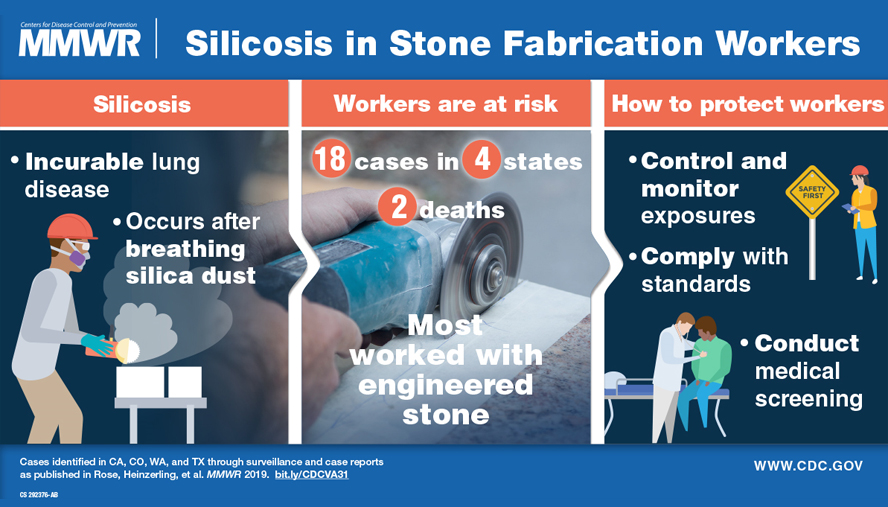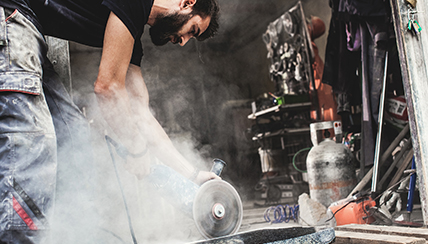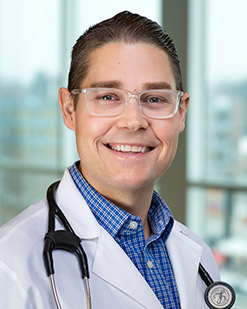Center of Excellence for Silicosis & its Prevention Program
What is silicosis?
Silicosis is a scarring disease of the lung caused by inhaling fine particles of crystalline silica dust. Chronic dry cough and shortness of breath are early symptoms of disease. Silicosis can worsen over time, especially with continued dust exposure. The disease typically takes 5–20 years after first exposure to appear.
 Image courtesy of U.S. Centers for Disease Control and Prevention.
Image courtesy of U.S. Centers for Disease Control and Prevention.
Who gets silicosis?
 People who work with or around products that contain and release respirable crystalline silica are at risk of silicosis.
People who work with or around products that contain and release respirable crystalline silica are at risk of silicosis.
Some products that contain silica (also referred to as quartz) include natural stone such as sandstone, marble and granite. Besides quartz, other mineral forms of crystalline silica include tridymite and cristobalite. Engineered (artificial) stone, a mixture of large amounts of quartz with binders (such as anhydride chemicals or epoxy resins), may release high concentrations of respirable silica when it is cut, grinded or polished for use in countertops, tiles and other applications.
Some industries where exposure to silica dust may occur include:
- Engineered stone fabrication
- Concrete mixing and cutting
- Sandblasting
- Brick and stone cutting
- Foundry work
- Construction
- Mining (including metal, stone, aggregate and coal mining)
- Fracking (hydraulic fracturing for natural gas extraction)
- Pottery manufacturing
Why is it important to recognize the exposure sources and early symptoms of silicosis?
Exposure to silica dust has been known for centuries to cause silicosis, yet many cases continue to occur in the United States and worldwide. A recent outbreak in stone fabrication workers has brought renewed attention to the disease. Silicosis is not reversible, but it is preventable. If workers are diagnosed with silicosis, they must be removed from exposure to minimize the risk for progression of fibrotic lung disease and for the other diseases associated with silica exposure.
What other diseases are associated with silica exposure?
- Chronic Obstructive Pulmonary Disease (COPD)/Emphysema
- Tuberculosis (TB) and other lung infections
- Lung cancer
- Kidney disease
- Autoimmune diseases (such as rheumatoid arthritis and scleroderma)
What services does National Jewish Health offer to workers who have been exposed to silica dust?
For workers:
- Diagnosis of silica-related diseases by board-certified occupational lung specialists
- Treatment of the complications of silicosis
- Careful attention to protecting personal health information
- Medical guidance for removal from dust exposure
- Benefits counseling
What clinical services do we provide?
- Detailed exposure and medical history-taking
- Physical Exam
- Lung Function Testing
- Chest X-Ray with B reading (a specialized interpretation for dust disease of the lung)
- QuantiFERON Tuberculosis (TB) blood testing
- Other diagnostic testing (such as high resolution chest CT scan, cardiopulmonary exercise testing, arterial blood gas testing, laboratory testing for autoimmune, kidney and infectious diseases)
Conditions Treated & Health Information
- Silicosis
- Other diseases associated with silica exposure including:
- Chronic Obstructive Pulmonary Disease (COPD)/Emphysema
- Tuberculosis (TB) and other lung infections
- Lung cancer
- Kidney disease
- Autoimmune diseases (such as rheumatoid arthritis)
Research
Check back soon about research opportunities.
Related Programs or Services
What resources are available:
If you have questions about silicosis, you can call the toll free or local number for the National Jewish Health Center of Excellence for Silicosis and Its Prevention:
- Local: 303-270-2609, option 2
- Toll Free: 877-255-5864, option 2
- Para alcanzar el Programa de Silicosis, llame al 877-255-5864 y presione el numero dos
What we offer to employers:
Under the 2017 OSHA Silica Standard, employers are required to comply by:
Making medical surveillance available at no cost to the employee, at a reasonable time and place, for each employee who will be required to use a respirator for 30 or more days per year
This surveillance must be performed a Physician or other Licensed Health Care Provider (PLHCP) with a baseline medical examination happening 30 days after initial assignment and periodic examinations at least every 3 years
The baseline medical examination must consist of:
- Medical and work history
- Physical examination
- Chest x-ray
- Pulmonary function test (PFT)
- Tuberculosis testing
- Any other tests deemed appropriate by the PLHCP
At National Jewish Health, we can offer employers:
OSHA-compliant medical screening and surveillance for early disease
OHSA-compliant respiratory protection services including medical clearance for respirator use and both qualitative and quantitative respirator fit testing.
Resources
Rose C, Heinzerling A, Patel K, et al. Severe Silicosis in Engineered Stone Fabrication Workers — California, Colorado, Texas, and Washington, 2017–2019. MMWR Morb Mortal Wkly Rep 2019;68:813–818. DOI: http://dx.doi.org/10.15585/mmwr.mm6838a1external icon. Severe Silicosis in Engineered Stone Fabrication Workers - California, Colorado, Texas, and Washington, 2017-2019
Colorado Health Alert Network (HAN) HAN Advisory - Silicosis in Stone Fabrication Workers - October 2, 2019
California Department of Health Hazard Warning for Workers in Spanish: https://www.cdph.ca.gov/Programs/CCDPHP/DEODC/OHB/CDPH%20Document%20Library/Silica_Hazard_Workers_sp.pdf
OSHA Silica Standard: https://www.osha.gov/dsg/topics/silicacrystalline/
The Center for Construction Research and Training – Work Safely with Silica: https://www.silica-safe.org/
- NIOSH Science Blog: http://blogs.cdc.gov/niosh-science-blog/2019/10/29/silicosis-countertop/
Doctors
-

Jeremy T. Hua, MD, MPH
-

Richard Kraus, PA-C
-

Cecile S. Rose, MD, MPH
Reasons to Choose National Jewish Health
- The leading respiratory hospital in the nation and the only one devoted fully to the treatment of respiratory and related illnesses
- Ranked #1 or #2 in Pulmonology by U.S. News & World Report for 26 consecutive years
- Ranked in the top 5% of hospitals in the nation by HCAHPS
- Physicians consistently recognized among the best in the nation by multiple services, including Best Doctors in America and Castle Connolly
- Among the top 6% of organizations funded for research by the NIH, providing patients access to hundreds of active clinical trials
- 124-year history of focus on care, research and education serving patients from around the world with lung, heart, immune and related disorders

Finding Care for Sarcoidosis in My Own Backyard
“The providers at National Jewish Health are problem solvers, not symptom solvers,” she stated. “They’re not willing to stop after fixing one problem, they look at the whole patient.”
Read More
 Clinical Trials
Clinical Trials